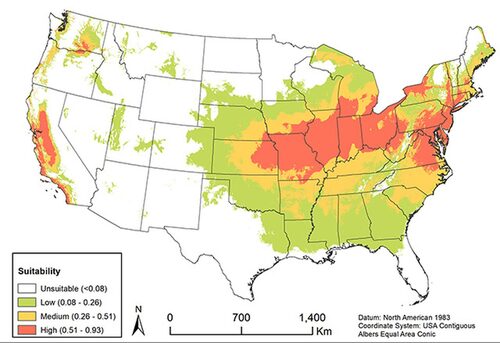
Areas in the United States that have been identified as possible spotted lanternfly habitat.U.S. Department of Agriculture image
The spotted lanternfly threatening $18 billion per year worth of Pennsylvania agriculture products could spread throughout the Mid-Atlantic and New England, west into Kansas, and show up on the West Coast, too.
U.S. Department of Agriculture scientists earlier this month released maps showing areas suitable as habitat for the non-native, invasive pest first found in the United States in Berks County in 2014.
The publication of the federal scientists’ projections comes as members of Congress asked the department to continue to step up funding in the fight against its impact.
A letter from 14 members of Congress to Agriculture Secretary Sonny Perdue noted a $7 million increase in the federal Fiscal Year 2020 budget to assist states in addressing the lanternfly and requests at least the same level of funding in the Fiscal Year 2021 budget.
U.S. Rep. Susan Wild was among those who signed onto the letter dated Oct. 8.
“The spotted lanternfly is not only a nuisance, but a threat to the farmers and agricultural leaders in the Greater Lehigh Valley," Wild, whose 7th Congressional District in Pennsylvania covers Lehigh, Northampton and southern Monroe counties, said in a statement. "From homeowners to our agricultural industry, everyone in Pennsylvania has been impacted by this pest and this funding would provide essential resources for research initiatives to help finally eradicate it. I am proud to join this bipartisan effort to stop the spread of this destructive and invasive species.”
In projecting how far the lanternfly may spread, the USDA’s Agricultural Research Service looked at the mean temperature of the driest quarter of the year: It cannot be too hot or too cold, with ideal conditions ranging from 19 to 45 degrees Fahrenheit.
Another important factor in predicting the possible range is the presence of the tree of heaven — an invasive plant that, like the lanternfly, originated from China, according to the researchers. Although not the plant-hopper’s only host plant, it is a highly important to the insect. Studies are underway to identify additional host plants and to find the right biocontrol system, the USDA researchers say.
Within the United States, the spotted lanternfly could eventually become established in most of New England and the Mid-Atlantic states, the central United States and Pacific coastal states, reports ecologist Tewodros Wakie with the Agricultural Research Service’s Temperate Tree Fruit and Vegetable Research Unit in Wapato, Washington, who led the project.
Worldwide, 11 European countries were found to be prime habitat for lanternflies to become established.
The pest threatens agricultural crops, including almonds, apples, blueberries, cherries, peaches, grapes and hops, as well as hardwoods such as oak, walnut and poplar.
“Pennsylvania Department of Agriculture analysis indicates the potential damage amounts to $18 billion per year statewide, which does not include further costs on other affected states,” the letter from the members of Congress states. "For example, in 2017, Chester County alone had $605,000 in Christmas trees and $1,845,000 in fruits, tree nuts and berries which could be a risk from spotted lanternflies.
“In addition to their economic impact on the agriculture and timber industries, we have heard strong concerns from many homeowners as this invasive insect can cover plants, cars, patios and outdoor items with a sticky, sugary substance that attracts other insects and promotes mold growth.”
The lanternfly cannot fly long distances but spreads its turf by hitching rides from infested areas. Also, its egg masses that are laid each fall can be transported to new locales.
This article is quoted from lehighvalleylive.com
